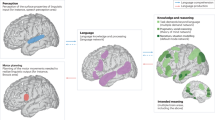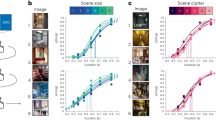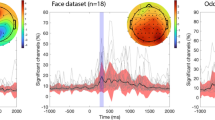Abstract
We assessed the role of the human mirror neuron system (MNS) in complementary actions using functional magnetic resonance imaging while participants prepared to execute imitative or complementary actions. The BOLD signal in the right inferior frontal gyrus and bilateral inferior parietal lobes was greater during preparation of complementary than during imitative actions, suggesting that the MNS may be essential in dynamically coupling action observation to action execution.
This is a preview of subscription content, access via your institution
Access options
Subscribe to this journal
Receive 12 print issues and online access
$209.00 per year
only $17.42 per issue
Buy this article
- Purchase on Springer Link
- Instant access to full article PDF
Prices may be subject to local taxes which are calculated during checkout


Similar content being viewed by others
References
di Pellegrino, G., Fadiga, L., Fogassi, L., Gallese, V. & Rizzolatti, G. Exp. Brain Res. 91, 176–180 (1992).
Gallese, V., Fadiga, L., Fogassi, L. & Rizzolatti, G. Brain 119, 593–609 (1996).
Fogassi, L. et al. Science 308, 662–667 (2005).
Rizzolatti, G. & Craighero, L. Annu. Rev. Neurosci. 27, 169–192 (2004).
Iacoboni, M. et al. Science 286, 2526–2528 (1999).
Heiser, M., Iacoboni, M., Maeda, F., Marcus, J. & Mazziotta, J.C. Eur. J. Neurosci. 17, 1123–1128 (2003).
Fadiga, L., Fogassi, L., Pavesi, G. & Rizzolatti, G. J. Neurophysiol. 73, 2608–2611 (1995).
Hamilton, A.F. & Grafton, S.T. J. Neurosci. 26, 1133–1137 (2006).
Buccino, G. et al. Neuron 42, 323–334 (2004).
Koski, L. et al. Cereb. Cortex 12, 847–855 (2002).
Schutz-Bosbach, S., Mancini, B., Aglioti, A.M. & Haggard, P. Curr. Biol. 16, 1830–1834 (2006).
Brass, M. & Heyes, C. Trends Cogn. Sci. 9, 489–495 (2005).
Iacoboni, M. & Dapretto, M. Nat. Rev. Neurosci. 7, 942–951 (2006).
Acknowledgements
The present study was supported by the EU-Project Joint Action Science and Technology (IST-FP6-003747).
Author information
Authors and Affiliations
Contributions
R.D.N.-N. and A.M.J.v.Z. conducted the experiment and analyzed the data. R.D.N.-N. wrote the manuscript with contributions from A.M.J.v.Z., H.T.v.S and H.B. The project was supervised by H.B.
Corresponding author
Ethics declarations
Competing interests
The authors declare no competing financial interests.
Supplementary information
Supplementary Fig. 1
Experimental stimuli and time course. (PDF 40 kb)
Supplementary Table 1
Locations in MNI coordinates and labels of brain areas involved in complementary actions in the current experiment. (PDF 9 kb)
Supplementary Table 2
Locations (in MNI coordinates) and Brodmann's labels (BA) for brain areas in which BOLD signal was significantly associated with facilitation effects (that is, fast responses – slow responses) observed in imitative and complementary contexts. (PDF 11 kb)
Rights and permissions
About this article
Cite this article
Newman-Norlund, R., van Schie, H., van Zuijlen, A. et al. The mirror neuron system is more active during complementary compared with imitative action. Nat Neurosci 10, 817–818 (2007). https://doi.org/10.1038/nn1911
Received:
Accepted:
Published:
Issue Date:
DOI: https://doi.org/10.1038/nn1911
This article is cited by
-
Brain mechanisms of social signalling in live social interactions with autistic and neurotypical adults
Scientific Reports (2023)
-
Experimental conditions in which dyads outperform individuals in a task of force produced by two people
Experimental Brain Research (2022)
-
Mechanisms for mutual support in motor interactions
Scientific Reports (2021)
-
Affordances, context and sociality
Synthese (2021)
-
Perception of action-outcomes is shaped by life-long and contextual expectations
Scientific Reports (2019)



